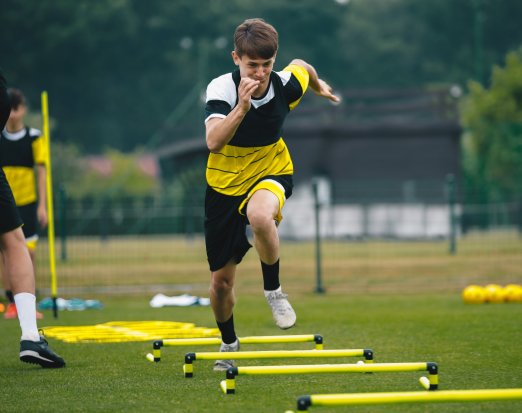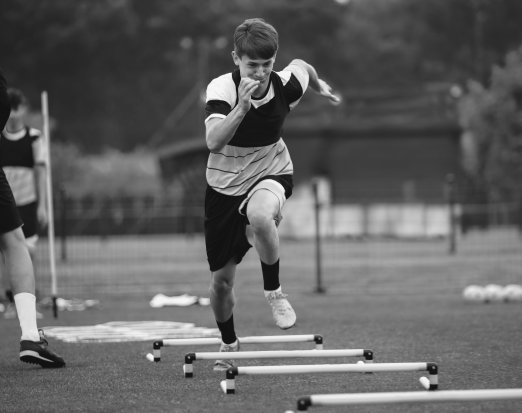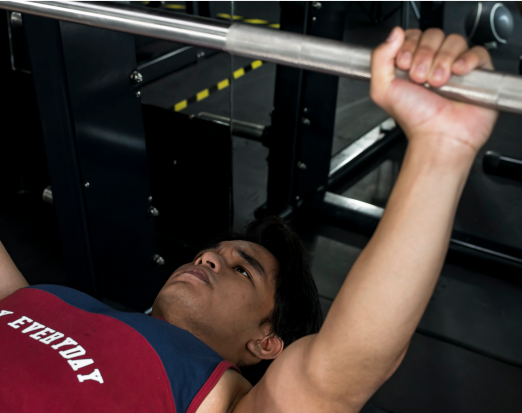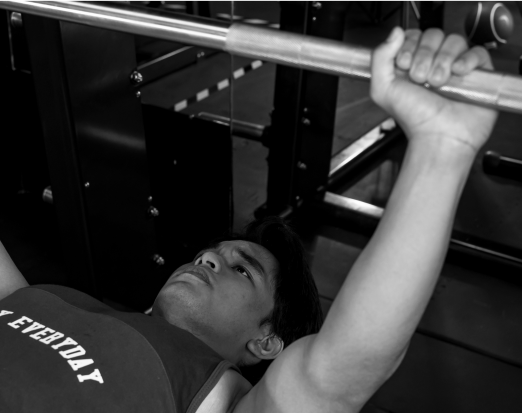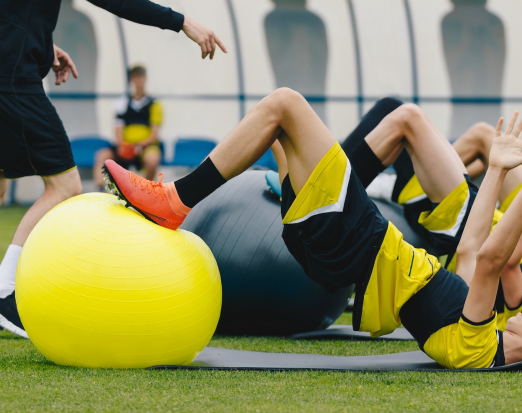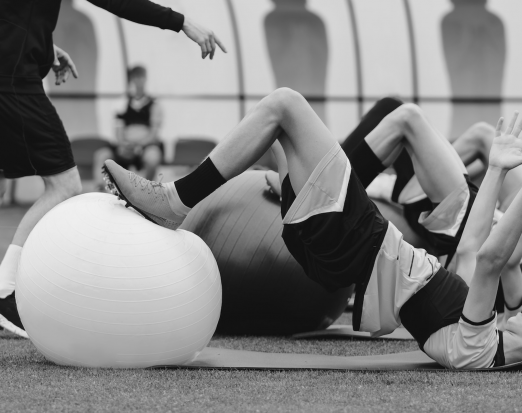Hop, Skip, & Jump to Performance
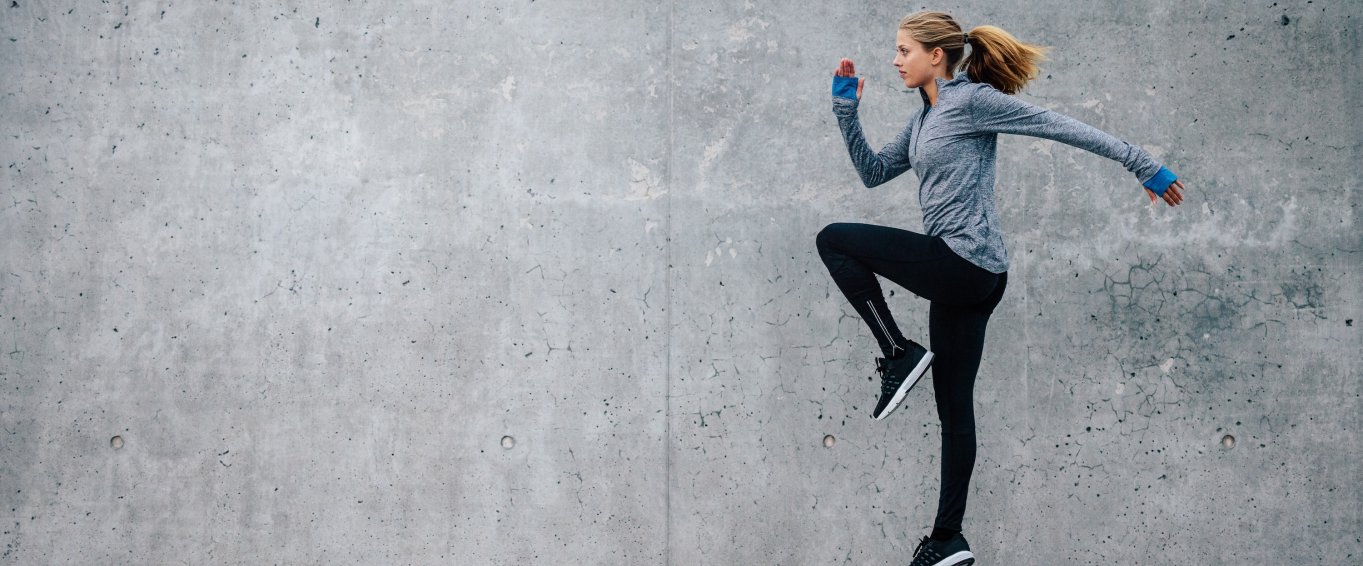
The ability to accelerate, jump, sprint, and change direction quickly are athletic qualities which are desirable for all athletes. A key and complex mechanism within these athletic qualities is the stretch-shortening cycle (SSC). The SSC helps the body-system in many sporting situations, for example, reflex-propulsive force to jump higher or when changing direction, to improved running economy through storing and utilising elastic-potential energy.
Therefore, an important consideration is how to train the SSC mechanism. Traditionally, exercises or drills that stimulate the SSC fall into a family of drills known as plyometrics. Plyometrics are generally dynamic movements – hops, skips, and jumps, that treat the lower body like springs. Through exposing the lower body (upper body can be trained too) as springs, the neuromuscular system learns and adapts to high forces, and depending on the activity, the neuromuscular can also adapt to be energy efficient reducing the metabolic cost of the activity.
The SSC mechanism is controlled both by neural reflex-feedback and muscular elements (11). In activities which utilise the SSC mechanism, the muscular system is taken through a relative eccentric (lengthening/elongation) action, followed by a short isometric contraction, and finally a very quick concentric (shortening) action. However, this series of muscular actions, especially the lengthening of the muscle, may alter as the athlete develops due to changes in pre-activation, stiffness, and muscle-tendon function (12).
These series of muscular actions in conjunction with the neural feedback are vital in athletic development, especially in youth athletes. The SSC mechanism seem to naturally develop through maturation, but findings also suggest that they are highly trainable (7). For example, youth athletes have seen improvements in jump ability, agility drills, acceleration, and high speed-running from completing plyometric training (3, 4, 5, 8, 13, 15).
As the SSC is demanding on the neural and muscular systems, especially as the eccentric actions occur mostly in the muscular system, with a further possible elongation in the tendon junction, the appropriateness of plyometric training has been questioned for young athletes. However, as plyometric activities are frequently observed in free play, for example, hopping, skipping, running, and dodging with no supervision or coaching, it seems that the body naturally selects and drives specific adaptations to enhance the SSC mechanism.
Youth Athlete Strength Training and Plyometrics
Young athletes with low strength levels have been shown to have less age-related development, which could alter SSC mechanisms including, tendon stiffness. This may lead the nervous system to use a medium or late reflex, which probably alters the forward feed system resulting in less muscular pre-activation (12). This combination of strategies may lead to longer ground contact times, as the system needs adequate time to decelerate the kinetic energy and further time to generate the appropriate force for propulsion. Furthermore, the system is also figuring out motor control skills, for example balance and coordination.
With athletes with low strength levels, it is suggested that they are exposed to a general strength training programme, as this will lead to neuromuscular adaptations (6). By exposing youth athletes to a range of strength exercises (squats, lunges and deadlifts) these exercises can help the athletes with general physical adaptations (anatomical adaptation) whilst also teaching the young athletes to focus on their posture (motor control), balance, and coordination.
Within the strength and conditioning community, some levels of relative strength have been recommended before starting a plyometric programme. These levels are relatively high, with some suggesting over 1.5 x bodyweight. A good level of strength, especially relative strength is always recommended, as this will help with the overall robustness of the athlete. However, the athlete’s strength level should not be a barrier to starting a plyometric programme, as the athlete can practice hops, skips, and jumps. Moreover, the athlete being exposed and learning a range of hops and skips, this can be counted as valuable practice time, which will help the athlete to develop rhythm and coordination.
Starting a Plyometric Programme
When starting a strength training programme, the intensity is normally expressed at a percentage of the athlete’s one-repetition maximum (%1RM), with a higher percentage being a greater intensity. It is extremely challenging, if not impossible, to use this intensity formula within plyometric drills, as the drills are frequently performed with bodyweight (bodyweight – mass (kg) and speed – velocity (m/s) are important factors). Generally speaking, the demand or ‘intensity’ of a plyometric drill is linked to the eccentric phase of the movement (peak forces when landing) and the amount of mechanical stress (7). However, and this is the challenge, the demand or ‘intensity’ of the plyometric drill will be slightly different for various athletes due to other factors – including tendon stiffness, pre-activation strategies, training background and experience (2). Therefore, when planning and coaching a plyometric session, considerations on landing, landing forces, as these factors will relate to the stress within the system, but also the coach should be observing the athlete’s overall motor control and coordination within each drill – quality is more important that quantity.
It is also noteworthy to mention that, especially within youth athletes, there is a period of time in learning the plyometric drills. Exposing the athletes to a range of hops, skips and jumps, the athletes will naturally perform the movements at a relatively lower speed and with longer contact ground times, which will place less demand or mechanical stress within the system (peak force) (10). As the athletes develop their rhythm, coordination, along with neuromuscular strategies, their speed will increase, and ground contact times will reduce.
As the athletes develop in their athletic journey, plyometric drills can be altered to be more aggressive and challenging. As previously mentioned, the speed, landing (landing/peak forces) will be linked to the demand or stress in the system. Performing single-leg drills, depth jumps, drop jumps, and even adding external load (medicine ball, dumbbells) are ways to increase the overall demand. Remember by altering a drill, for example, going from a two footed hop to a single-leg hop, is a completely different task for the athletes. The athletes will need to learn a new strategy for this drill, which will affect their overall speed, ground contact time, motor control, and coordination. The athletes need time to practice and develop effective strategies, so that they can improve their speed, use appropriate ground contact times, and movement efficiency.
Volume, Contacts, and Training Frequency
The training volume is an important metric when coaching youth athletes through a plyometric programme. Typically, training volume is calculated by the number of contacts multiplied by the number of sets. For example, hops on the spot, 6 repetitions (contacts) x 2 sets = 12 contacts. Training volume.
As we have discussed, plyometric drills do have the potential to be demanding on the muscular-tendon systems, therefore training volume should be kept low (see table from McNeely 2005). Furthermore, full rest or long rest periods are recommended between sets, as this will help to keep the skill level high. Training frequency should also start low, with 1 – 2 sessions per week, on non-consecutive days (1). As the young athletes develop, quality of the movement is more important than quantity, with the main aim of the plyometric drill being to enhance speed, neural mechanisms, coordination, and motor control.
| Level | Low | Medium | High |
| Beginner | below 80 | 60 | 40 |
| Intermediate | below 100 | 80 | 60 |
| Advanced | below 140 | 120 | 100 |
Foot Contacts for Different Levels of Ability. Table from McNeely (2005).
Summary
Plyometrics are an essential training mode for all youth athletes; inexperienced to experienced. With young inexperienced athletes, plyometrics should be seen as fun way to explore their movement vocabulary and to learn new skills, particularly balance, coordination, and rhythm. As the athletes learn and develop plyometric motor strategies, it’s highly recommended that youth athletes combine strength training with plyometric drills, as a combination of strength and plyometric training seems to drive further SSC adaptations and aids in sprinting, jumping and agility performances.
Long-term physical preparation requires regular practice, especially in youth athletes, as their physical preparation is in conjunction with their natural growth and maturation. By supporting youth athletes and giving them the opportunity to explore a wide range of training activities and drills, we can improve their robustness, skilfulness, enjoyment, and be fully prepared for their sport.
Youth Strength & Conditioning Platform for Schools, Sport Clubs, and Academies.
Our platform helps to deliver effective training and tracks athletic progress and development, with the core objectives of reducing the risk of injuries and to promote both sport readiness and performance. The platform’s features include -
- Strength and conditioning tests and dashboard to compare and contrast athlete metrics
- Athlete app - athletes can discover new exercises and train independently
- Track data - monitor athlete’s training loads, RPE, and training adherence
- Reports - simply create squad, team, and individual athlete reports
- Full curriculum - follow a strength and conditioning curriculum with a library of session plans
References
- Bedoya, A.A., Miltengerger, M.R., & Lopez, R.M. (2015). Plyometric training effects on athletic performance in youth soccer athletes: A systematic review. Journal of Strength & Conditioning Research, 29(8), 2351 – 2360.
- Brearly, S., Wild, J., Agar-Newman, D., & Cizmic, H. (2017). How to monitor net plyometric training stress: guidelines for the coach. UK Strength & Conditioning Journal, 47, 15 – 24.
- Chaabene, H., & Negra, Y. (2017). The effect of plyometric training volume in prepubertal male soccer players’ athletic performance. International Journal of Sports Physiology and Performance, 12(9), 1205 – 1211.
- Chelly, M.S., Hermassi, S., & Shephard, R.J. (2015). Effects of in-season short term plyometric training program on sprint and jump performance of young male track athletes. Journal Strength & Conditioning Research, 29(8), 2128 – 2136.
- Gaamouri, N., Hammami, M., Cherni, Y., Rosemann, T., Knechtle, B., Chelly, M.S., & Van Dan Tillaar, R. (2023). The effects of 10-week plyometric training program on athletic performance in youth female handball players. Frontiers in Sports and Active Living, 1 – 10.
- Kumar, N.T.A., Oliver, J.L., Lloyd, R.S., Pedley, J.S., Radnor, J.M. (2021). The influence of frowth, maturation and resistance training on muscle-tenon and neuromuscular adaptations: A narrative review. Sports, 9(59), 1 – 24.
- Lloyd, R.S., Meyers, R.W., & Oliver, J.L. (2011). The natural development and trainability of plyometric ability during childhood. Strength & Conditioning Journal, 33(2), 23 – 32.
- Mathisen, G.E. (2014). Effect of high-speed and plyometric training for 13-year-old male soccer players on acceleration and agility performance. Journal of Sport Science, 5(2), 1 – 12.
- McNeely, E. (2005). Introduction to plyometrics: converting strength to power. NSCA’s Performance Training Journal, 6(5), 19 – 22.
- McNeely, E. (2007). Practical guidelines for plyometric intensity. NSCA’s Performance Training Journal, 6(5), 12 – 16.
- Nicol, C., Avela, J., Komi, P.V. (2016). The stretch-shortening cycle. A model to study naturally occurring neuromuscular fatigue. Sports Med, 36(11), 977 – 999.
- Radnor, J.M., Oliver, J.L., Waugh, C.M., Myer, G.D., Moore, I.S., & Lloyd, R.S. (2018). The influence of growth and maturation on stretch-shortening cycle function in the youth. Sports Med, 48, 57 – 71.
- Ramirez-Campillo, R., Meyan, C., Alvarez, C., Henriquez-Olguin, C., Martinez, C., Canas-Jamett, R., Andrade, D.C., & Izquierdo, M. (2014). Effect of in-season low-volume high-intensity plyometric training on explosive actions and endurance of young soccer players. Journal Strength & Conditioning Research, 28(5), 1335 – 1342.
- Singh-Bal, B., Jeet-Kaur, P., & Singh, D. (2011). Effects of a short-term plyometric training program of agility in young basketball players. Brazilian Journal of Biomotricity, 5, 271 – 278.
- Thomas, K., French, D., & Hayes, P.R. (2008). The effect of two plyometric raining techniques on muscular power and agility in youth soccer players. Journal Strength & Conditioning Research, 23, 1 – 4.
